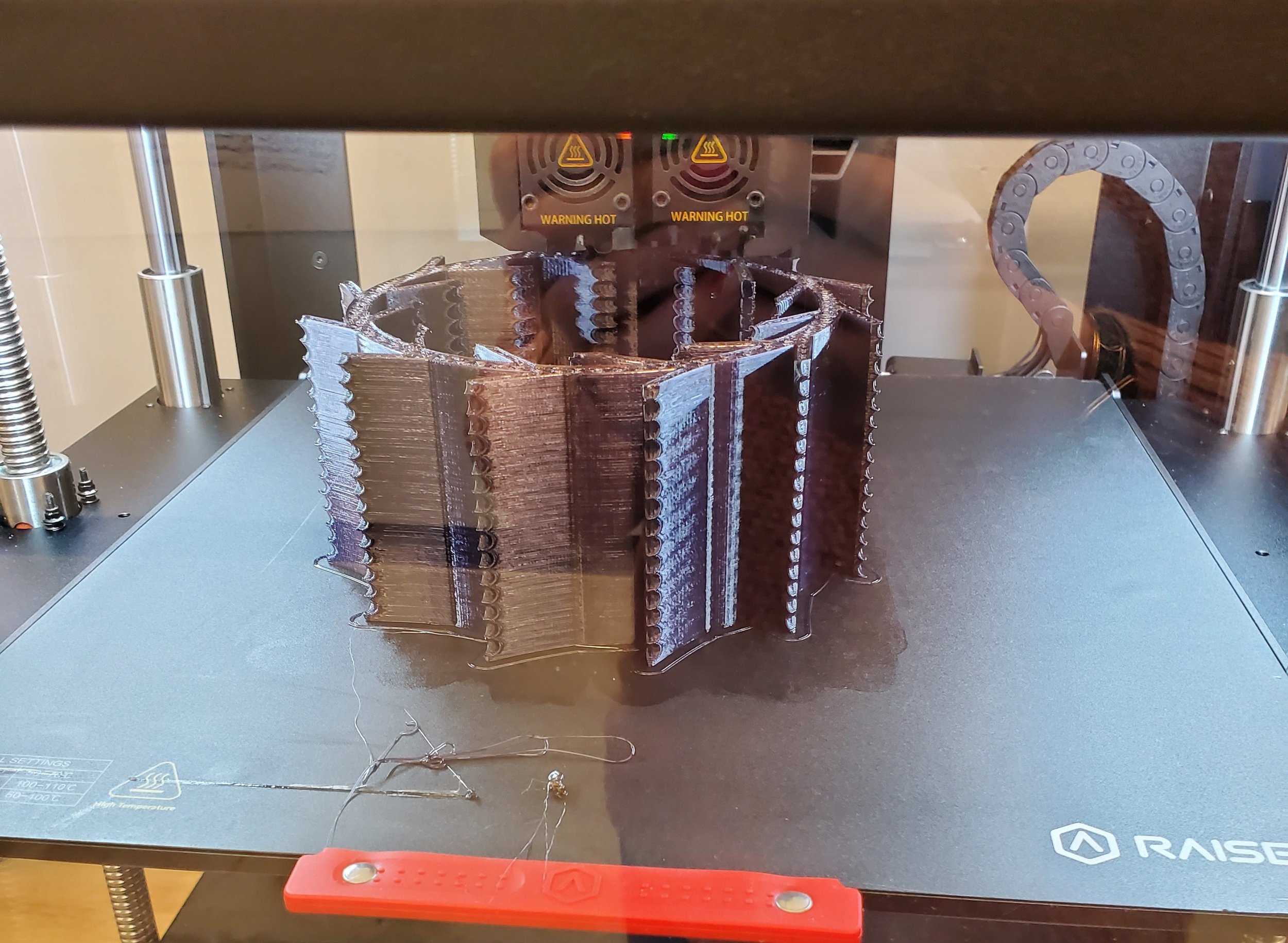R&D Prototyping with Industrial Additive Manufacturing and CO2 Laser Cutting
By Brittany Marshall
At Continuous Solutions, our team is focused on ways to build next generation technology and collaboration. Our commitment did not waiver during the pandemic. The pandemic showed just how fragile the global supply chain and business ecosphere can be in times of crisis, in addition, how critical it is for small businesses to work collaboratively.
In our lab, we expanded our offerings in engineering services to local businesses, and in the past year and a half have added additive manufacturing (3D printing), laser cutting and CNC milling capabilities to our repertoire for prototyping. These capabilities not only allow us to offer services to other businesses but also assist in rapid prototyping and fabrication of technologies for in-house research and development projects.
Continuous Solutions’ 3D printers work by feeding and heating a filament, a reeled ‘string’ of plastic or other meltable material, heating it to its melting point, and then extruding it down onto a surface. This occurs repeatedly over several layers, building a structure by adding more material in small increments, hence the term additive manufacturing.
Ian Fox is our subject matter expert at 3D printing, with over ten years of experience with the still relatively fresh technology. “Everything from mounting brackets, insulated parts, making of molds…” he says when discussing everything that has been printed on the CS printers. He gestures over to the two Raise3D Pro3s currently standing idle. “They’re our workhorse printers.”
He isn’t exaggerating either. Between those two printers, there have already been over 1000 hours of printing time logged, and that’s just in little over a year. “[They’re]…what I call commercial grade.” With 300x300x300 mm printing volumes and print temperatures of up to 275 Celsius, the two Raise3D products can provide prints for most applications. They can print filaments from your common PLA up to ‘commercial-grade’ ones such as nylon, Delrin, and polycarbonate. The printers feature dual nozzle feeders: “we have ruby nozzles on the primary of each so they can print more abrasive filaments.”
One of Our Raise3D Pro3s in Action
Continuous Solutions’ 3D printers have capabilities for printing various types of plastics. Initially this technology served as a method of one-off prototyping for research and development purposes; it now serves as a means to build production grade technology.
An industrial grade 3D printer was added shortly after the Raise3D units. It serves as a high temperature, high performance material printer with a very large printing area.
“[It’s a] massive behemoth of a machine,” Ian describes. He’s referring to the Aon M2 Plus, with its impressive 400x400x600mm print volume. “It is an industrial grade printer, can print between 300 and 500 degrees Celsius.” Temperatures that are so high that a magnetically held bed surface would not work because magnetic fields start to break down in such a high temperature, so the printer instead utilizes a vacuum system to hold the surface in place.
The temperature range of the printer allows for printing in a wider range of materials. “We have access to PEEK, PEI, and have a carbon fiber version of PEEK,” Ian explains. These filaments allow for high precision tooling, can be aerospace and medical grade, and produce mechanically stronger and/or electrically insulated components, broadening the use-cases for Continuous Solutions’ 3D printing services.
With our fleet of 3D printers and printing experts, Continuous Solutions is primed to provide printing services to small businesses and organizations in the Portland, Oregon area and beyond. Our team of experts can review designs, ensure proper slicing (the term for the translation of a solid, 3D model to a design that can be additively manufactured), print, perform quality inspections, and even provide some finishing services. As these services continue to be rolled out, we are developing a pricing plan that “…will be transparent to the end user.”
In addition to 3D printing services, Continuous Solutions has also added additional capabilities via a professional laser cutting system. This system from Full Spectrum Laser features a 90W laser and can perform many functions that may be appealing to designers and makers in many different industries. Again, Ian explains: “[the laser] can etch surface coatings in metal and can cut through a lot of other materials.”
Continuous Solutions’ 90W Laser Cutter
The laser cutter produces a highly attuned, precise laser that is then directed via a laser head. This laser head is moved along two axes with computer numerical control (CNC) that is derived from a two-dimensional model. The intensity of the laser is adjusted automatically by the computer when going from cutting to etching or vice-versa.
The system requires liquid cooling of the laser itself and filtration of exhaust from cutting and etching operations. The laser cutter can cut through materials such as wood, plastics, foams, acrylic, and more up to one quarter of an inch in thickness. The operating bed for the system is two by three feet, with extensions available for feeding through longer materials.
The Laser Cutter in Action
Our laser cutting system can provide precision cutting and etching for many possible uses, including enclosures, shipping containers, branding, rapid prototyping of designs slated for fabrication to ensure tolerances and fitting, art, and more. Advantages to laser cutting as compared to other methods of cutting and etching materials include its high precision, relatively fast speeds, and reduction in waste.
Between 3D printing and laser cutting services, Continuous Solutions has already served researchers, scientists, makers and other customers in several different industries, such as academia, consumer goods, industrial defense R&D, and more.
Interested in utilizing these services? Check out our Contact page and fill out the form. We’d be happy to help you!



